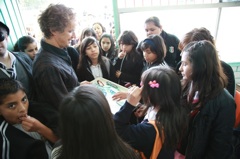Yves Behar: improving kids' vision via eye-catching design

Back in 2009, the dynamic San Francisco-based designer Yves Behar gave me a sneak preview of a few prototypes he was working on. One of these prototypes was a set of very hip-looking eyewear with colorful mix-and-match frames. They looked like something you'd purchase at a chic, high-end boutique. But instead, they were low-cost spectacles targeted for children who needed help with their vision but would be stigmatized if they wore glasses.Behar and his studio, fuseproject, intended to give them away for free to school kids in the so-called developing world and other areas of the globe where resources might not be plentiful.
In 2010, one year after showing me the prototype, Behar launched the project (which fuseproject calls the Verbien See Better to Learn Better initiative)in Mexico, in partnership with Augen Optics and the Mexican Government. So far, See Better to Learn Better has resulted in 500,000 free eye exams and 358,000 schoolchildren outfitted with free glasses, all in Mexico. And on September 1, Behar and fuseproject won a prestigious Index Award, a respected international prize for "design for good" projects, for See Better to Learn Better.

Behar said that the funds fuseproject received from the Index Award, which has a 100,000-euro prize and is considered to be the largest monetary design award in the world, will be alotted to expanding the program. This will be not only in Mexico but also in other international regions--including the San Francisco/Bay Area (in conjunction with non-profit Tipping Point, under the name See Well to Learn), as well as in remote areas of Indonesia (in collaboration with the Sumba Foundation).
While Behar was in Copenhagen to receive the prize, I was able to ask him, via e-mail, about the strategies behind his award-winning eyeglass distribution project. The innovation consists of not only the physical design of the frames, but also the concept of bundling them with the eye-exams and giving them away to kids.
Here's our exchange.
You are the only designer to have won an Index Award twice. You won in the past for your design for One Laptop Per Child, which produced a low-cost computermeant for use by kids in areas without plentiful resources. Did any research you conducted or learnings from the OLPC project feed into the See Better to Learn Better initiative?
The research we benefitted from most was the one that explained the stigma that exists in Mexico, and all-over South America, for wearing corrective eyeglasses. They are seen as a handicap. The insight allowed us to develop a unique concept that allows for the kids to choose unique color combinations, shapes and sizes of the frames...and in the field what we saw is the more the kids saw other’s original designs, the more they want to make their own version.
See Better to Learn Better will soon have a San Francisco presence. Do you foresee kids who are not in need wanting the glasses--they are very cool--and could a commercial component continue to fuel the production of the "design for good" component?
I have been following the Charles Eames precept “the best, to the most, for the least”, and I have made attainability central to the majority of our projects. It’s been an eye-opener for me to be working with non-profits, and being able to reach extreme efficiency in production. In my opinion there is a very good chance we can develop a for-profit model of See Better, that will finance the non-profit and continue to give-away eyeglasses for free. This is what we will be working on next.
How important are aesthetics when designing for communities in need? You've said beauty and desirability are important in the "green" area. Does that also apply in other areas, especially in healthcare and education?
Products and experiences that deliver on quality, design, durability, beauty are simply better understood, more loved, and have a deeper/longer impact on the user. That is true for people in need just as much as for people who are comfortable. There is so much to design in areas that have been neglected, specially areas where the consumer has been ill-treated by a lack of quality and beauty so prevalent in healthcare and education. But how long can people be miss-treated by bad design? Not much longer I believe. Designers know this; business and politicians are getting there too.
Related on SmartPlanet:
Yves Behar: Designers 'must put the sexy back in green' by Andrew Nusca
All photos: fuseproject
This post was originally published on Smartplanet.com
